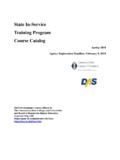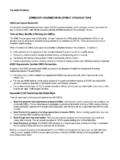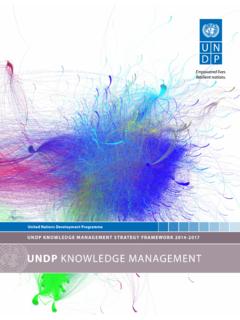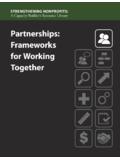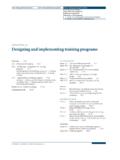Transcription of chapter 51 Human resources management and capacity …
1 chapter 51 Human resources management and capacity developmentPart I: Policy and economic issuesPart II: Pharmaceutical managementPart III: management support systemsPlanning and administrationOrganization and managementInformation managementHuman resources management51 Human resources management and capacity development52 Designing and implementing training programsSummary Recognizing the crisis in Human resources for health Addressing the crisis in the short and long terms Understanding the role of HRM at all levels of the health care system Assessing the strength of HRM in the organization Encouraging Human resources leadership at the organizational level Assessing staffing requirements Recruiting and hiring needed workers Developing and maintaining a performance management system
2 Establishing a responsive supervisory system Improving motivation, retention, and productivity through HRM responsibility for fairness in the workplace HRM responsibility for setting work priorities HRM responsibility for providing feedback on performance HRM responsibility for providing meaningful work HRM responsibility for professional development of Using channels of communication the channel Nonverbal communication Improving communication Feedback Preparing job descriptions a job description Staff orientation Staff procedures Disciplining staff Handling conflict style Accommodating style Avoiding style Collaborating style Compromising Delegating Conducting meetings
3 For effective meetings Skills of chairingAssessment guide and further readings 51-1 Staff pressure map 51-2 Sample job description for a chief pharmaceutical supplies officer 51-1 Pharmaceutical personnel, density per 100,000 population in selected countries, 2007 08 51-2 Australia s rural pharmacy program strategies to increase pharmacy staff in underserved areas 51-3 Human resources development components 51-4 Comparison of communication channels 51-1 FIP, UNESCO, and WHO Pharmacy Education Taskforce Plan of Action 2008 10 51-2 The Human resources for health framework 51-3 Benefits of establishing a strong HRM system 51-4 Recruitment action checklist studiesCS 51-1 Using partnerships to improve HR capacity to deliver pharmaceutical services in Namibia 51-2 Supporting task shifting to build HR capacity in pharmaceutical management in Kenya 51-3 Using a regional resource to build capacity in pharmaceutical management 51-4 Assessing Namibian pharmaceutical sector capacity to support the scale-up of HIV/AIDS programs 51-5 Instituting an emergency hiring plan in Kenya 51-6 Using performance-based financing to increase worker
4 Retention and service quality in Rwanda management sciences for health Human resources Recognizing the crisis in Human resources for healthCountries throughout the world, especially developing countries, have long suffered from a severe lack of skilled health workers and managers. The delivery of health ser-vices is labor intensive, and the workforce is the primary determinant of health system effectiveness, yet strategies and systems for Human capacity development in most min-istries of health are inadequate to meet the needs of the population. In addition, the lack of health staff, including trained pharmacy staff, has compromised health care in rural areas. Moreover, the demands of scaling up antiret-roviral treatment (ART) programs and the related time-consuming care have overburdened already weak systems for Human resources development and management and drained personnel from other health services.
5 Absenteeism and low morale are widespread, and work-related stress reduces health workers with a high prevalence of HIV/AIDS that can-not address acute shortages in the short term are unable to deliver effective services. In these countries, staff attrition rates are rising because of HIV infection, illness, and death as well as the migration of staff to urban areas or other coun-tries. Vacancy rates in public-sector organizations are also rising, while the pool of skilled candidates to fill positions is still not deep enough. Results from a twelve-country survey showed that the problem is so serious that countries simply do not have the Human resources capacity to absorb, deploy, and use additional funds that they are receiving to improve health (Kinfu et al.)
6 2009). Estimates cited in the survey indi-cate that workforces in the most-affected countries would need to increase by up to 140 percent to attain health devel-opment targets. The pharmaceutical personnel situation in many coun-tries is dire; for example, countries such as Benin and Mali have less than one pharmaceutical worker for every 100,000 people, whereas France, in comparison, has more than 100 per 100,000 (Table 51-1). Uganda has an esti-mated 30 percent of the pharmacists it actually needs (Matsiko and Kiwanuka 2003). Some industrialized coun-tries also have pharmacy staff shortages; many areas of the Human resources are central to planning, managing, and delivering health services, including pharmaceutical services.
7 In most countries, personnel account for a high proportion of the national budget for the health sector often 75 percent or more. Despite the critical importance of Human resources to the functioning of pharmaceuti-cal management programs, few concerted efforts have addressed the severe staff shortages facing the health sector in many countries. The HIV/AIDS pandemic has intensified this already serious addition to staffing shortages, the health system faces many Human resources challenges, including Human resources planning, recruitment, deployment, training, staff motivation, and staff development . The root causes of these issues can be traced to years of neglect, low sala-ries, poor workplace climate, and limited capacity to train and update staff skills.
8 Interventions needed to alleviate the Human resources crisis include short-term actions, such as task shifting, while in the long term, countries need to expand their capacity to train enough staff to fill needs. Some issues need to be addressed at the national level (for example, compensation), but many can be addressed through better leadership and Human resource management (HRM) at the facility level. In the pharma-ceutical sector, the goal of HRM is to develop and sustain an adequate supply of skilled professionals who are moti-vated to provide a high level of pharmaceutical addressing Human resources challenges requires improved leadership and management at all levels. An expanded HRM role, especially at the facility level, is needed to transform the outdated view of Human resources as mainly an administrative function to one where the Human resources staff work closely with man-agers to support the health goals of the organization and to ensure that the right staff with the right skills are in place to meet these people is an important and challenging task for any manager.
9 Employees are motivated by many factors that can be affected by management . Receiving effective supervision, perceiving they are fairly treated, under-standing their job priorities, getting feedback, feeling valued and appreciated, and having opportunities for pro-fessional development can all help staff perform better. Developing and maintaining a fair, equitable, and effec-tive HRM system can motivate staff and increase their level of job satisfaction and efficiency, which can result in improved service quality. An important part of a long-term strategy is creating an organizational and management structure for HRM that is implemented by managers and staff at all levels. A Human resources part-nership between senior managers, supervisors, Human resources professionals, and individual staff members is what makes an HRM system 51 / Human resources management and capacity development States have some difficulty filling pharmacist posi-tions (FIP 2009).
10 The dynamics of entry and exit from the health workforce in many countries remains poorly understood, and many reasons such as lack of investment in training, illness, and premature retirement and death contribute to the shortage. This lack of understanding inhibits countries and development partners from developing and implementing appropriate interventions. Several factors, however, are rec-ognized as important contributors to the shortage of trained pharmacy personnel and other health care workers, includ-ing Migration of health personnel: Migration contributes signifi-cantly to the loss of health workers from many countries. For example, almost two-thirds of ghana s 140 pharmacy school graduates in 2003 migrated to a different country; between 2001 and 2004, Zimbabwe had about 150 new pharmacy graduates, while 100 Zimbabwean pharma-cists registered to work in the United Kingdom during the same period (FIP 2006).











